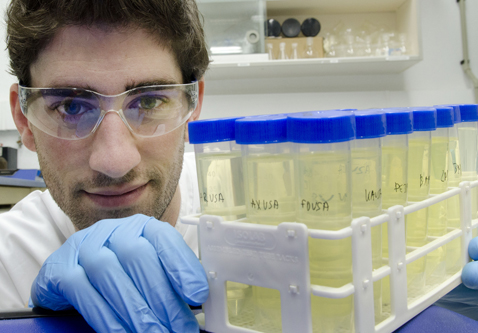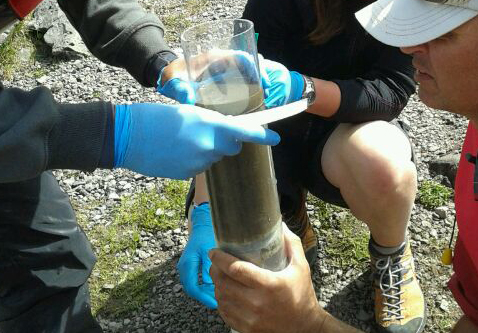In his thesis Azibar Rodriguez, a researcher in the IBeA research group, has examined the geographical distribution of metal pollution in estuaries and high-altitude mountains, how it has changed over time and its toxicological consequences. One of the conclusions of the research is that metal pollution caused by the traffic in the area and industrial activities reaches the atmosphere of the Pyrenees through the air.
Metal pollution caused by industry and traffic finds its way to the Pyrenees
A PhD thesis of the UPV/EHU-University of the Basque Country reveals that metal pollution caused by humans can be found in the vegetation and lakes of the Pyrenees
First publication date: 01/02/2016

Metal pollution was the main focus of the thesis produced by Azibar Rodriguez, of the Research and Analytical Innovation (IBeA) research group. Metal elements do not degrade either chemically or biologically, so they remain in the environment. What is more, bearing in mind that they may be toxic, they can cause serious problems. Rodriguez is an expert in investigating the pollution caused by metals and metalloids —elements that have properties of both metals and non-metals— in natural systems.
While he was working on his thesis he investigated the extent of the metal pollution in the waters, sediments, living organisms etc. and also the geographical distribution of the pollution and how it changes over time in the following five estuaries located across the world: in the estuary of the Tubarão river in the state of Santa Catarina in Brazil; in the Cávado estuary in the Portuguese city of Esposende; in the Hugli river in Bengal in Eastern India, —one of the most important tributaries of the Ganges delta—; and in the Basque Country, in the Oka estuary of the Urdaibai Biosphere Reserve and in the Nerbioi-Ibaizabal estuary. And then to study the effects of atmospheric metal pollution, he analysed the metal pollution of the vegetation of the Pyrenees and the sediments of 18 lakes above an altitude of 2,000 metres. So the thesis has been divided into seven sub-sections and Rodriguez points out that from each one "we have drawn different conclusions, because each case and zone is different and has its own characteristics."
With respect to the atmospheric metal pollution, they analysed the leaves, lichens and mosses in the Irati forest, to study the geographical distribution of the atmospheric metal pollution of the Pyrenees. So they have shown that metal elements of anthropogenic origin produced as a result of the activity of the industries in the area (such as steel production) and the traffic are carried over large distances by the westerly wind. What is more, they have concluded from the research conducted on the 18 lakes that "the former mining activities and the massive burning of fossil fuels in recent years have had a direct influence on the ecosystem of the lakes," said the researcher.
The metal pollution in the Nerbioi-Ibaizabal and Urdaibai areas has improved
With respect to the two estuaries studied in the Basque Country, the researcher says that the situation has improved: "Over time the toxicity that the sediments could exert on living organisms has fallen and the metal pollution is increasingly less." The concentrations of metal elements in the sediment samples taken in 50 points in the Nerbioi-Ibaizabal estuary were measured in 2009, 2010, 2011 and 2014 and the evolution that these concentrations have undergone over time were analysed. This characterisation will be useful in quantifying the consequences that today's building on the Zorrotzaurre island —the moving of the sediments, the change in the hydrodynamic situation, etc.— could have on the state of the estuary in the future. In the research it became clear that "the metal pollution of the sediments had significantly changed between 2009-2011 and 2014": indeed, "in the samples taken in 2014 the points that had the greatest concentrations ever seen until that moment emerged around the Abra and the Port docks, and it could be the result of the works undertaken to enable large vessels to enter the port."
In the estuary of the Oka river in the Urdaibai Biosphere Reserve the concentrations of the metal elements in the sediments and in the oysters were analysed to study the geographical distribution of the metal pollution in the estuary and its evolution over time. Monitoring work was carried out every three months between 2010 and 2011. In addition, the health of the estuary's oysters was analysed by measuring the biological indices of the oyster cells and tissues. "The toxicity of the sediments was low and was consistent with the minor alterations in the biological indices detected in the oysters," said the researcher. When comparing the data recorded in this research with other research conducted previously, he concluded that "the health of the oysters has improved as the years have passed".
Azibar Rodriguez's thesis is an international one and he spent several months at the University of Edinburgh. During that time he conducted research into pollution caused by silver nanoparticles by analysing the sediments in the Hugli river in Bengal in Eastern India. As the researcher pointed out, "pollution linked to nanoparticles is an emerging one and we analysed the sediments of the river to see if there were any silver nanoparticles". Even though a very sensitive technique for detecting nanoparticles was used, "no silver nanoparticles were detected in the sediments of the Hugli river. But with everything learnt there we will start to go further into the nanoparticle issue here," he said.
Additional information
Azibar Rodriguez (Bilbao, 1987) is a graduate in Environmental Science, he did a Master's in Environmental Pollution and Toxicology and has a PhD in Analytical Chemistry. He wrote up his thesis entitled Metal pollution in estuaries and high altitude mountains: geographical distribution, evolution in time and toxicological implications in the Department of Analytical Chemistry of the Faculty of Science and Technology and his supervisors were Alberto de Diego and Silvia Fernandez.
Photo caption: Azibar Rodriguez taking samples of sediments in the Pyrenees (Azibar Rodriguez / UPV/EHU).



